|
|
|
Sort Order |
|
|
|
Items / Page
|
|
|
|
|
|
|
| Srl | Item |
| 1 |
ID:
127617
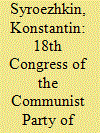

|
|
|
|
|
| Publication |
2013.
|
| Summary/Abstract |
The struggle at the very top of China's political establishment reached its peak on the eve of the 18th Communist Party Congress; this largely predetermined the balance of political forces in the upper echelons of the Communist Party and the decisions of its congress. The compromise about the top figures makes the party's political future very dim indeed. Although the retreating Hu-Wen Tandem managed to hold its ground, it is too early to say that the "reformers" have scored a final victory: in many respects the 18th Congress proved to be "transitional."
The final balance of power will become clear in five years' time after the next, 19th CPC Congress. It will probably clarify the course of the "fifth generation" of the country's leaders. It seems that the next five years can be best described as time of compromises. One has to admit that the criticized Hu-Wen Tandem left the country in fairly good shape; it compiled a reasonable "roadmap" with no alternative on the horizon.
It remains to be seen whether the new party and country leaders will manage in the next five years to avert social upheavals and fulfill the tasks formulated by the 18th Congress while following the roadmap.
|
|
|
|
|
|
|
|
|
|
|
|
|
|
|
|
| 2 |
ID:
127615


|
|
|
|
|
| Publication |
2013.
|
| Summary/Abstract |
This article takes a look at the national and local elections held in Armenia in 2012-2013, examining in particular the opportunities they created for political competition, the validity of the election results, their consequences, and so on. The author prefaces his study by first examining the national elections held in Armenia in the 1990s and 2000s. Furthermore, he focuses on the viewpoints that are still pertinent today and can enhance our understanding of the current election processes. Whenever possible, the author presents a detailed review of all the statistics currently available to characterize the election process and the development of the domestic political situation in Armenia several years after the 2008 presidential election.
|
|
|
|
|
|
|
|
|
|
|
|
|
|
|
|
| 3 |
ID:
127583
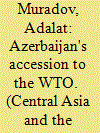

|
|
|
|
|
| Publication |
2012.
|
| Summary/Abstract |
The service sector is developing dynamically in the world and its share in GDP is growing from year to year. According to the IMF, the share of services in world GDP amounts to 63.2%, whereby the U.S. accounts for 80% and the EU for more than 70% of world GDP. World practice also shows that the share of added value in the service sphere is much higher than in industry and agriculture.
The total volume of exported services is also increasing at a rapid rate. For example, the volume of exported services in world trade increased from $155 billion in 1975 to $2.5 trillion in 2005, i.e., it has risen more than 15-fold in thirty years.
|
|
|
|
|
|
|
|
|
|
|
|
|
|
|
|
| 4 |
ID:
127576
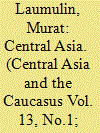

|
|
|
|
|
| Publication |
2012.
|
| Summary/Abstract |
In Central Asia, religion is gradually coming to the fore in everyday life as a fairly integrated phenomenon with a wide range of functions: consolidation of ethnic self-awareness, shaping spiritual and moral culture together with the awareness of being part of a religious and the world community; fulfilling social functions through religious prescriptions; formulating the ideals of social justice, as well as man's duty to the state and the state's to man, etc.
Some of the functions, however, are internally contradictory: consolidation of the religious community does not always bring society together. In other words, in some cases religion might exacerbate the relations between the state and the religious part of society.
Religious consolidation not infrequently revives old problems and breeds disagreements inside society; conscientious believers often make too rigid demands of the state (which turns them into the opposition), while any encroachments on the religious principle of fairness may stir up protest feelings.
|
|
|
|
|
|
|
|
|
|
|
|
|
|
|
|
| 5 |
ID:
127572
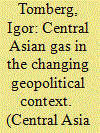

|
|
|
|
|
| Publication |
2012.
|
| Summary/Abstract |
The 21st century has confronted mankind with hitherto unknown dangers: the planet's natural resources, particularly energy supplies, have been depleting at a fast pace, which has stirred up fierce and mounting rivalry over hydrocarbons and other raw materials. In 2011, the growing instability in North Africa and the Middle East added fuel to the smoldering fire, increased the volatility of the energy markets, and cast doubts on continued and consistent fuel supplies from these and adjacent regions. Central Asia, in turn, is potentially threatened by the unwelcome developments around Afghanistan and Iran; ambitious investment projects (particularly in the energy sphere) are being jeopardized since investors are justifiably worried that a conflict with Iran might spread, in one form or another, to its Caspian neighbors.
|
|
|
|
|
|
|
|
|
|
|
|
|
|
|
|
| 6 |
ID:
127574


|
|
|
|
|
| Publication |
2012.
|
| Summary/Abstract |
When the fourth generation of leaders came to power in China, the country began drawing up its policy in Central Asia (CA) on the concept of peripheral diplomacy, which since 2005 has been based not on the thesis of "China's peaceful rise," but on the theory of "peaceful development" that came to replace it, as well as on the idea proposed by Hu Jintao of "working together to build a harmonious world." At present, China's relations with the regional states are being established in keeping with the concept of "friendly, peaceful, and prosperous neighbors" (mulin, anlin, fulin) confirmed at the 17th congress of the CPC. As Fudan University Professor Zhao Huasheng, a leading Chinese specialist on CA, emphasized, this concept, which was formulated as early as 2003, reflects the new approaches to relations with neighboring countries.
|
|
|
|
|
|
|
|
|
|
|
|
|
|
|
|
| 7 |
ID:
127575
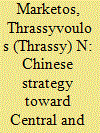

|
|
|
|
|
| Publication |
2012.
|
| Summary/Abstract |
As China's economy has grown and become integrated into the global market, both have become interdependent. Therefore China's long-term development goals will only be possible with increasing and stable access to foreign trade, resources, and energy. The latter has become a pressing issue as the country's dependence on international energy imports rapidly increases and might impose a limit on its growth if left unmet. This is especially important given supply shortages as a result of the recent events in Libya and given the future prospect of supply disruptions from the Middle East. In the case of oil, the International Energy Agency (IEA) forecast in 2010 that Chinese imports would grow from 4.3 million barrels a day (m/bd) in 2009 to 12.8 m/bd in 2035, thus rising from 53% to 84% of the total demand. The issue of resource shortages will play an even more prominent role in international relations and will become an increasing source of conflict among major powers. Given the fact that some countries are more generously endowed with strategic resources, this opens up the possibility of using these tools for political gain. Historically, economic diplomacy has contributed to the shifting balance of power in the world. Nations have more often been inclined to employ economic measures in pursuit of foreign policy objectives when "the legitimacy of the power of existing structures of international cooperation decreases." The result of the current realignment of geo-economic power will encourage nations to reassess the effectiveness of their energy, economic, and foreign policies.
|
|
|
|
|
|
|
|
|
|
|
|
|
|
|
|
| 8 |
ID:
127581


|
|
|
|
|
| Publication |
2012.
|
| Summary/Abstract |
On 1 January, 2012, the official opening of the Common Economic Space (CES) of Belarus, Kazakhstan, and Russia, which moved customs control to the outer border of the Customs Union (CU) in July 2011, launched a qualitatively new stage in integration development in the post-Soviet expanse. The objective conditions for consolidating economic cooperation among the three countries have long emerged, the technical work, in the best interests of all the partners concerned, has been carried out, and the top leaders are showing sufficient political will. So there is every reason to believe that the driving force behind post-Soviet integration in the CU-CES format has sprung into action.
Flat duty and tax rates on imported goods, sanitary and veterinary control, and technical regulation principles have been in effect for Russia, Belarus, and Kazakhstan alike since the middle of 2011. On 1 January, 2012, a basic set of documents on the CES consisting of 17 agreements came into force that address the rights of migrant workers and the members of their families, standard principles of currency policy, access to railroad transport services, standard regulations for the support of agricultural goods producers, and conditions for ensuring free movement of capital. All of this will help to form a common market with more than 170 million consumers and a total gross product of more than $1,385 billion.
|
|
|
|
|
|
|
|
|
|
|
|
|
|
|
|
| 9 |
ID:
127579
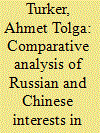

|
|
|
|
|
| Publication |
2012.
|
| Summary/Abstract |
In addition to the recent violent ethnic conflict in Kyrgyzstan, some of the other events attracting attention to politics in Central Asia are the Georgian-Russian war, the Color Revolutions, the Andijan events in Uzbekistan, the Karimov government's subsequent decision to end U.S. basing rights, Kazakhstan's economic rise, and the leadership change in Turkmenistan. At the same time, the security situation in Afghanistan and the growing insecurity about energy supplies has heightened the interest in security and economic cooperation in Central Asia. Russia and China have been reacting to these same pressures.
|
|
|
|
|
|
|
|
|
|
|
|
|
|
|
|
| 10 |
ID:
127618
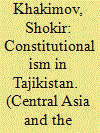

|
|
|
|
|
| Publication |
2013.
|
| Summary/Abstract |
This article examines how constitutionalism is taking shape in present-day Tajikistan and analyzes its main development stages in 1994 (the drawing up and adoption of the first RT Constitution), 1999 (the constitutional reform), and 2003 (the introduction of amendments and additions to the current RT Constitution).
This study defines the general features of constitutionalism of the transition period, which include the following:
1. The broad reception of foreign law, as well as implementation of the international legal provisions of human rights, the democratic foundations of statehood, the separation of powers, and the rule of law while retaining the regulations passed down from Soviet times.
2. The general contradictoriness and inconsistency of the constitutional rulemaking.
3. The transformation of certain provisions of the Constitution into a declaration of intentions, relating to their lack of correspondence to the real political and socioeconomic situation in the country.
It reveals the lack of correspondence between the content of the Constitution and the old legislation largely inherited from the Soviet past and presents the content of the constitutional reform carried out in 1999 within the framework of executing "The General Agreement on Establishing Peace and National Consent in Tajikistan."
The author analyzes the amendments and additions to the Constitution, the adoption of which was brought up at the 1999 referendum.
The article presents an appraisal of the constitutional reform of 2003 and examines the problems of carrying it out, during which favorable conditions were created for the emergence of authoritarianism in the country.
It also notes that Tajikistan's sociopolitical reality creates prerequisites for differences between the de jure and de facto constitution. This usually leads in practice to a certain shift from democracy to authoritarian methods of executing state power.
|
|
|
|
|
|
|
|
|
|
|
|
|
|
|
|
| 11 |
ID:
127614
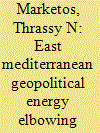

|
|
|
|
|
| Publication |
2013.
|
| Summary/Abstract |
The Leviathan gas deposit discovered in the Eastern Mediterranean Israeli Exclusive Economic Zone (EEZ) in 2010 by the U.S. Noble Energy Company is in fact Syria's stake in "democratization." The drilling of natural gas has given birth to a new conflict in the region: Israel, Syria and the Gaza Strip claiming drilling rights as well.
Cyprus (an EU member country) has not given up either, nor has Lebanon, which asked the U.N. to recognize its right to drill in its territorial waters, Hezbollah being the most vocal in this regard.
Turkey presented Syrian President Bashar al-Assad with the project of a Qatar-Saudi Arabia-Iraq-Syria-Turkey gas pipeline, via which natural gas could have been exported to Europe too, to the detriment of the Russian Federation, however the Syrian President refused, implementing Iran's natural gas pipeline project instead.
Construction of the natural gas pipeline started immediately. Spurred on by the U.S., Turkey, Qatar, and Saudi Arabia began directly supporting the Muslim Brotherhood as a destabilizing element for the "traitorous" regimes that were negotiating the Leviathan's potential with Iran, Russia, China, and India.
Turkish warships are engaged in all kinds of conflicts with American, Israeli, and Cypriot prospecting vessels in the Mediterranean Sea. Turkey imports 60 per cent of its natural gas needs from Russia and cannot allow its "historical enemy" to manage the Leviathan deposit too. It is hoped that the advantage will be reversed once the Muslim Brotherhood comes to power.
This analysis, based on the neo-realist school of thought in geopolitics, aspires to shed light on the geopolitical game being played astride the media coverage of the Syrian civil war and Eastern Mediterranean gas deposit potential.
|
|
|
|
|
|
|
|
|
|
|
|
|
|
|
|
| 12 |
ID:
127611
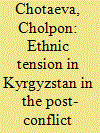

|
|
|
|
|
| Publication |
2013.
|
| Summary/Abstract |
The author analyzes the ethnocultural and psychological factors contributing to the continued ethnic tension in Kyrgyzstan in the post-conflict period. These factors figured prominently in the flare-ups of ethnic tension and continued ethnic strain. Dr. Chotaeva proceeds from the results of an ethnosociological survey carried out in five regions of Kyrgyzstan.
The ethnocultural factors are related to various aspects of ethnic identity-the extent to which the family and close relatives affect ethnic self-identity and the degree to which the survey respondents were familiar with their ethnic history and follow ethnic traditions and customs in everyday life. The psychological factors were determined by the degree of trust the members of one ethnic group feel toward another.
The sociological survey also included questions designed to identify the respondents' civic identity, which directly depends on the degree to which the republic's ethnic groups are integrated and which, on the other hand, is slowed down by ethnic and regional specifics. The continued ethnic tension has intensified an awareness of ethnic identity; however the sociological survey demonstrated that a common civic identity still prevails over ethnic identity. The absolute majority of the respondents consider themselves to be citizens of Kyrgyzstan and are not contemplating emigration.
|
|
|
|
|
|
|
|
|
|
|
|
|
|
|
|
| 13 |
ID:
127610
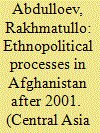

|
|
|
|
|
| Publication |
2013.
|
| Summary/Abstract |
Throughout the 20th century, domestic policy in Afghanistan unfolded under the influence of the ethnic factor. In 1929, the mainly Tajik Habibullah Kalakani movement ended the rule of Amanullah Khan; the National Democratic Party of Afghanistan, which split along ethnic lines, was another factor that brought about his downfall.
In 1992, the mujahideen came to power; this ignited ethnic confrontation and the country's de facto division into ethnically homogenous parts. The Islamist Taliban movement, which relied on the Pashtoon majority, established an unprecedentedly cruel regime and made the country the world center of terrorism and extremism.
In 2001, the International Conference on Afghanistan held in Bonn could not ignore the role of the ethnic factor; it figured prominently while the Constitution was discussed and later adopted, as well as during the parliamentary and presidential elections.
|
|
|
|
|
|
|
|
|
|
|
|
|
|
|
|
| 14 |
ID:
127623


|
|
|
|
|
| Publication |
2013.
|
| Summary/Abstract |
This article examines the phenomenon of the shadow (hidden) economy and its influence on Kazakhstan's financial and economic development and security. The republic's statistical bodies often use the term "non-observed economy," which implies hidden, unaccounted, informal, and illegal economic activity. Non-observed economic activity includes the production of goods and services, as well as the illegal redistribution of revenue and assets. Based on how widespread shadow and corruption processes are and on the current level of Kazakhstan's economic development, it can be concluded that when pursuing a policy to combat the shadow economy, attention should be placed not so much on reducing its scope as on raising the efficiency of the entire governance system. Furthermore, the state should play a leading role in managing socioeconomic processes.
|
|
|
|
|
|
|
|
|
|
|
|
|
|
|
|
| 15 |
ID:
127613
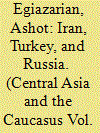

|
|
|
|
|
| Publication |
2013.
|
| Summary/Abstract |
The author discusses the semi-peripheral strategies of Iran, Turkey, and Russia in Central Asia and the Southern Caucasus, as well as their trade expansion; he establishes that the semi-periphery countries, Russia and China in particular, dominate the region's imports.
He looks at all sides of Iran's "struggle against exploitation" strategy, analyzes its impact on individual economies, and reveals the semi-peripheral function of neo-Ottomanism from the world-systems perspective.
The author's analysis of Russia's strategy allows him to conclude that after switching from mercantilism to integration with the leaders of the capitalist world-system, Russia can increase its semi-peripheral role and strengthen its position in the region.
|
|
|
|
|
|
|
|
|
|
|
|
|
|
|
|
| 16 |
ID:
127577


|
|
|
|
|
| Publication |
2012.
|
| Summary/Abstract |
The Republic of Daghestan is the largest of the North Caucasian republics in terms of territory (50.3 thousand sq km) and population size (2.1 million). It borders on five states in the south of Russia: Azerbaijan and Georgia on land and Kazakhstan, Turkmenistan, and Iran across the Caspian. It has administrative borders with the Stavropol Territory, Kalmykia, and Chechnia. The incredible confessional and ethnic diversity of Daghestan is also a result of its very specific history and no less specific geographic location.
There are 2,451 religious units in the republic: 2,396 of them are Muslim; 50 Christian; and 5 Judaic. The Christian communities are Orthodox (19 in all), Old Believer (1), Armenian (2), and Protestant (28, 6 of which are Seventh Day Adventists; 5 are Pentecostals; 5 are Baptists of the Union of the Evangelical Baptist Christians of Russia; 5 are Baptists of the Council of the Churches of the Evangelical Christian Baptists of Russia; 1 is Good Tidings Evangelicals; and 6 are Jehovah's Witnesses). The majority of the republic's population are Muslims; the structural diversity of Islam, the predominant religion, is present in all spheres of social life.
|
|
|
|
|
|
|
|
|
|
|
|
|
|
|
|
| 17 |
ID:
127625


|
|
|
|
|
| Publication |
2013.
|
| Summary/Abstract |
Based on an analysis of the changes going on in the sectoral structure of Tajik industry, this article justifies the need to carry out its regular restructuring.
|
|
|
|
|
|
|
|
|
|
|
|
|
|
|
|
| 18 |
ID:
127620


|
|
|
|
|
| Publication |
2013.
|
| Summary/Abstract |
The author analyzes the personnel shifts in 2012 and during the first month of 2013 in the Republic of Kazakhstan to point out that despite the scope (the government, local executive structures, and central state security services received new people), the country's state administration bodies did not undergo any rejuvenation. Furthermore, the personnel shifts in the defense and security structures (the police investigation departments in particular) show that the country's leaders attach particular importance to the processes going on inside the country and want to keep them under control.
Ten regions received new akims (heads of the administrative-territorial units) who, when appointed, were warned about the possible repercussions of embezzlement and misuse of budget money. New instruments of control over what the akims are doing in their regions have been created in the hopes of reducing the still fairly widespread nepotism to a minimum.
There is another interesting side to the personnel shifts of 2012-2013: just as in Russia, the parliament of Kazakhstan is turning into a "waiting room" or "depot" of sorts where deputies either await a new appointment or live out the remaining days of their political career.
The 2012-2013 rotations are described as the first steps toward implementing a new program called the Kazakhstan-2050 Strategy. The political priorities and implementation methods, however, will never change: the president remains in charge of everything up to and including the choice of prime minister.
|
|
|
|
|
|
|
|
|
|
|
|
|
|
|
|
| 19 |
ID:
127612


|
|
|
|
|
| Publication |
2013.
|
| Summary/Abstract |
It is hardly possible to correctly and fully assess the functioning and development of a regional security system without presenting a complete account of the entire range of ties and relations among the actors involved and the degree of influence of all the powers concerned.
Based on a case study of the post-Soviet space, the author studies the involvement of powers in regional security systems; his analysis of the key parameters of this involvement makes it possible for him to identify and describe two types of involvement: full and partial.
|
|
|
|
|
|
|
|
|
|
|
|
|
|
|
|
| 20 |
ID:
127621


|
|
|
|
|
| Publication |
2013.
|
| Summary/Abstract |
The ouster of authoritarian President Kurmanbek Bakiev in April 2010 was heralded as opening the door to a new era of human, press, and political rights protections in Kyrgyzstan. However, the interim administration of President Roza Otunbaeva and the accession of her democratically elected successor, President Almazbek Atambaev, on 1 December, 2011, failed to produce the anticipated, significant commitment to restore and safeguard press rights. Drawing on interviews with journalists and mass media experts in Bishkek and Osh, this article examines the press rights situation and restraints in the first year of the Atambaev administration. It concludes that achievement of a strong press rights record will be neither easy nor swift in light of Kyrgyzstan's Soviet-era and post-independence history, economic constraints, and political fragility.
|
|
|
|
|
|
|
|
|
|
|
|
|
|
|
|
|
|
|
|
|